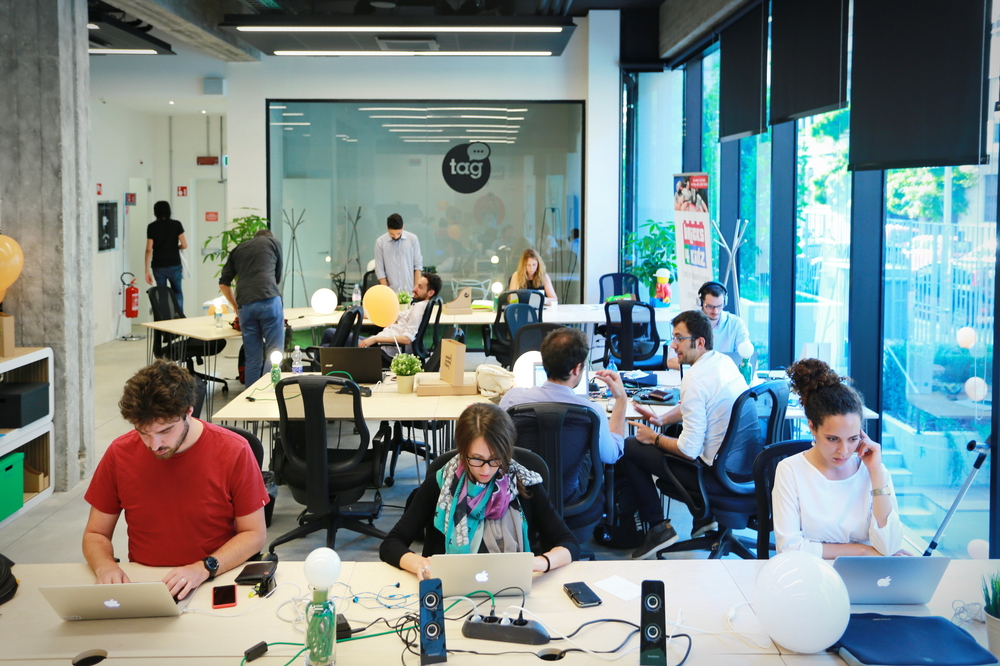
Office Sharing vs. Coworking – What’s the Difference?
In the evolving landscape of modern work environments, the concepts of office sharing and coworking have emerged as innovative solutions that cater to the needs of diverse professionals and businesses. While both approaches offer flexible workspace options, they differ in purpose, structure, and the experiences they offer.
In this story
Definition of Office Sharing
Office sharing refers to a workspace arrangement where multiple businesses or individuals share a leased office space. This model typically involves dividing a larger office into smaller, designated areas for each tenant, allowing them to benefit from shared amenities such as conference rooms, reception areas, and office equipment. Office sharing is often favored by small businesses, startups, or freelancers seeking a professional setting without the financial burden of a full office lease. It provides a cost-effective solution by splitting expenses among tenants while still offering a degree of privacy and independence. The primary focus of office sharing is on resource efficiency and cost savings, with less emphasis on community or networking opportunities.
Definition of Coworking
Coworking, in contrast, centers around a communal workspace where individuals from different companies or industries work alongside each other in a shared environment. This model is designed to foster collaboration, creativity, and a sense of community among its members. Coworking spaces are often open-plan and flexible, offering various seating options such as hot desks, dedicated desks, and private offices, along with shared facilities like meeting rooms, kitchens, and event spaces. The ethos of coworking extends beyond just providing a place to work; it encompasses a culture of networking, learning, and mutual support. Many coworking spaces host events, workshops, and social gatherings to facilitate connections and knowledge sharing among members, creating an ecosystem that thrives on collaboration.
Purpose of Understanding the Differences
Understanding the differences between office sharing and coworking is crucial for businesses and professionals looking to choose the most suitable workspace environment. Each model offers distinct advantages and caters to different needs and preferences. For instance, businesses that prioritize privacy and a traditional office setup may lean towards office sharing, while those seeking a vibrant community and networking opportunities might find coworking more appealing.
Moreover, comprehending these differences helps in making informed decisions about workspace investments, ensuring alignment with business objectives, cultural values, and budgetary constraints. The choice between office sharing and coworking can significantly impact productivity, employee satisfaction, and overall business growth. As the nature of work continues to evolve, recognizing these distinctions becomes increasingly important in navigating the myriad of workspace solutions available in today’s market.
In conclusion, while office sharing and coworking both offer flexible workspace alternatives, their distinct characteristics and purposes serve different segments of the professional community. By understanding these nuances, individuals and businesses can select the most appropriate environment to support their work and enhance their professional journey.
Characteristics of Office Sharing

Office sharing has become a practical solution for businesses seeking to optimize resources and reduce costs while maintaining a professional setting. By understanding its core characteristics, businesses can better assess whether this model aligns with their operational needs and goals.
Shared Office Space and Amenities
At the heart of office sharing is the concept of dividing a larger office space among multiple tenants. This arrangement allows businesses to share common areas and resources, such as conference rooms, reception areas, break rooms, and office equipment like printers and copiers. The shared nature of these amenities not only reduces individual costs but also fosters an efficient use of space that might otherwise be underutilized. Each tenant typically has their own dedicated workspace within the shared office, providing a balance between communal and private areas. This setup can be particularly appealing for businesses that require a professional environment but do not need a full office suite.
Typical Users and Use Cases
Office sharing is often favored by small to medium-sized enterprises (SMEs), startups, and freelancers who seek a cost-effective alternative to traditional office leases. It is especially beneficial for businesses that need a physical presence but have fluctuating or modest space requirements. Professional service providers such as consultants, lawyers, and accountants may choose office sharing to maintain a prestigious address and access to meeting facilities without the overhead of a standalone office. Additionally, companies expanding into new markets may use office sharing as a temporary solution to establish a foothold without committing to long-term leases. The model offers flexibility and scalability, allowing businesses to adjust their space usage as their needs evolve.
Cost and Contractual Arrangements
One of the significant advantages of office sharing is its cost-effectiveness. By sharing office space and resources, tenants can significantly reduce their overhead expenses. Office sharing arrangements typically involve simpler contractual agreements than traditional leases, often with shorter terms and more flexible conditions. This flexibility can be particularly advantageous for businesses that anticipate growth or changes in their operational needs. Tenants usually pay a monthly fee that covers rent, utilities, and access to shared amenities, providing a transparent and predictable cost structure. This arrangement allows businesses to allocate more resources toward core activities rather than office maintenance and management.
In conclusion, office sharing offers an efficient and economical workspace solution for businesses that value flexibility and resource optimization. By sharing office space and amenities, companies can maintain a professional environment while reducing costs and maintaining the ability to adapt to changing needs. This model provides a strategic advantage for businesses looking to balance operational efficiency with financial prudence.
Characteristics of Coworking

Coworking spaces have revolutionized the concept of traditional work environments by emphasizing community, collaboration, and flexibility. They cater to a diverse range of professionals seeking not only a place to work but also a vibrant community that fosters creativity and innovation.
Community and Collaboration Focus
At the core of coworking is a strong emphasis on community and collaboration. Unlike conventional office settings, coworking spaces are designed to facilitate interaction among members, encouraging them to share ideas, resources, and expertise. This environment fosters a sense of belonging and community, where members can network, form partnerships, and collaborate on projects. Many coworking spaces organize events, workshops, and social activities to further enhance community engagement and professional development. This collaborative ethos attracts freelancers, entrepreneurs, and remote workers who value the opportunity to connect with like-minded individuals and benefit from diverse perspectives.
Types of Coworking Spaces
Coworking spaces come in various forms, each catering to different needs and preferences. Some are open-plan environments that promote interaction and fluidity, while others offer a mix of private offices, dedicated desks, and hot desks to accommodate different work styles. Specialized coworking spaces may focus on specific industries or interests, such as tech startups, creative professionals, or social enterprises, providing targeted resources and support. Additionally, some coworking spaces are part of larger networks that offer access to multiple locations, both locally and globally, giving members the flexibility to work from different cities or countries as needed. This diversity in coworking spaces allows individuals and businesses to choose an environment that best suits their professional goals and lifestyle.
Membership Models and Flexibility
A key characteristic of coworking is its flexible membership models, which provide various options to suit different needs and budgets. Members can choose from daily, weekly, or monthly passes, as well as longer-term memberships that offer discounted rates and additional benefits. This flexibility allows individuals to tailor their coworking experience to their specific requirements, whether they need a consistent workspace or prefer the freedom to drop in as needed. Coworking spaces often include amenities such as high-speed internet, meeting rooms, printing facilities, and kitchen areas, with costs typically included in the membership fee. This all-inclusive approach simplifies budgeting and allows members to focus on their work without the distractions of managing office logistics.
In conclusion, coworking spaces offer a dynamic and collaborative environment that supports innovation and professional growth. By prioritizing community, providing diverse workspace options, and offering flexible membership models, coworking spaces meet the needs of a modern workforce seeking connection and adaptability. This model not only enhances productivity and creativity but also creates a supportive network that empowers individuals and businesses to thrive.
Comparative Analysis
When evaluating office sharing and coworking, it’s essential to understand both their similarities and differences in terms of purpose, culture, and functionality. These models, while geared towards providing flexible workspace solutions, cater to different professional needs and preferences.
Similarities Between Office Sharing and Coworking
Both office sharing and coworking models offer flexible workspace solutions that aim to optimize space utilization and reduce the overhead costs associated with traditional office leases. Each model provides shared amenities such as meeting rooms, office equipment, and common areas, which allow businesses and individuals to benefit from resources without incurring the full expense of maintaining a standalone office. Additionally, both environments support a variety of users, from freelancers and startups to established businesses seeking to enhance their operational efficiency. By offering flexible terms and shared resources, both models cater to the evolving needs of a modern workforce.
Key Differences in Purpose and Culture
Despite these similarities, office sharing and coworking diverge significantly in their purpose and cultural orientation. Office sharing primarily focuses on cost efficiency and resource optimization. It provides businesses with a professional setting where they can maintain a certain level of privacy and independence while benefiting from shared resources. The culture in an office-sharing environment is typically more formal, with less emphasis on interaction and community-building among tenants.
In contrast, coworking spaces are designed with a strong emphasis on community and collaboration. While they also offer cost-saving benefits, the primary purpose of coworking is to create a dynamic environment where individuals from diverse backgrounds can connect, collaborate, and innovate. The culture in coworking spaces is generally more informal and open, fostering networking opportunities and a sense of belonging among members. This collaborative ethos is often supported by events, workshops, and social activities to enhance engagement and professional growth.
Advantages and Disadvantages of Each
Each model presents distinct advantages and disadvantages that cater to different user needs. Office sharing offers the advantage of a professional and private workspace, which can be particularly appealing to businesses that require a formal office environment without the high costs of a traditional lease. However, the potential drawback is the lack of community engagement and networking opportunities, which can limit collaboration and idea exchange.
Coworking, on the other hand, excels in providing a vibrant and interactive community that supports creativity and innovation. The diverse and collaborative culture can lead to valuable networking opportunities and partnerships. However, the informal and open nature of coworking spaces might not suit everyone, particularly those who prioritize privacy and quiet over social interaction. Additionally, the dynamic environment may pose challenges for businesses that require a more structured and consistent workspace.
In conclusion, while office sharing and coworking both serve the need for flexible workspaces, their distinct purposes and cultural orientations make them suitable for different types of users. By understanding these nuances, businesses and individuals can select the model that best aligns with their operational requirements and professional aspirations.
Considerations for Choosing Between Office Sharing and Coworking

Selecting the right workspace model is pivotal for businesses and professionals aiming to align their environment with their operational goals and personal preferences. When deciding between office sharing and coworking, several considerations come into play, each impacting the effectiveness and satisfaction of the workspace solution.
Business Needs and Objectives
The choice between office sharing and coworking should begin with a clear understanding of the business’s core needs and objectives. Organizations that prioritize a professional setting with a degree of privacy and control may find office sharing more suitable. This model supports businesses that require dedicated spaces for client meetings and confidential work, offering a structured environment that mirrors traditional office settings. Conversely, businesses and individuals focused on innovation, networking, and collaboration might benefit more from coworking spaces. These environments foster community engagement and provide opportunities for spontaneous interactions that can lead to creative partnerships and fresh ideas, aligning well with companies that thrive on collaboration and open communication.
Work Environment Preferences
Personal and organizational preferences regarding the work environment play a crucial role in the decision-making process. Office sharing typically appeals to those who prefer a quieter, more private setting where they can concentrate without distractions. It suits individuals or teams that need to maintain focus on specific tasks or projects. On the other hand, coworking spaces attract those who enjoy dynamic and interactive environments. These spaces are ideal for individuals who value community and the chance to engage with a diverse group of professionals. The choice ultimately depends on whether the priority is on maintaining a controlled environment or embracing a more fluid and socially rich workspace.
Cost and Flexibility Considerations
Financial considerations and the need for flexibility are also key factors in choosing between office sharing and coworking. Office sharing can provide a cost-effective solution for businesses looking to minimize overhead while still accessing necessary office amenities. The shared expenses make it an attractive option for budget-conscious companies seeking stability without the commitment of long-term leases. However, coworking spaces offer unmatched flexibility, with a variety of membership models that cater to different levels of commitment and usage. This flexibility is advantageous for freelancers, startups, or businesses with fluctuating space requirements, allowing them to scale their workspace needs up or down as circumstances change.
In conclusion, the decision between office sharing and coworking hinges on a careful evaluation of business needs, work environment preferences, and financial considerations. By thoroughly assessing these factors, businesses and individuals can select the workspace model that best supports their goals and enhances their work experience. This strategic alignment ensures that the chosen environment not only meets current demands but also facilitates future growth and adaptation.
Conclusion: Recap of Key Points and Future Trends in Workspace Solutions
In exploring the nuances between office sharing and coworking, it becomes evident that both models offer unique advantages tailored to different needs within the modern professional landscape. Understanding these differences is crucial for businesses and individuals aiming to optimize their workspace for productivity, collaboration, and cost-efficiency.
Office sharing provides a structured and cost-effective solution for businesses seeking a professional environment without the financial burden of a full office lease. It emphasizes resource efficiency by sharing amenities like meeting rooms and office equipment among tenants, making it ideal for small to medium-sized enterprises and professional service providers that require privacy and stability. Conversely, coworking spaces thrive on community and collaboration, offering a vibrant atmosphere where individuals from various industries can network and innovate. With flexible membership models and diverse workspace options, coworking caters to freelancers, startups, and companies that prioritize connectivity and creative synergy.
Both models share similarities in offering flexible workspace solutions that reduce overhead costs and promote efficient use of space. However, they differ significantly in cultural orientation and purpose, with office sharing focusing on privacy and resource optimization, while coworking emphasizes interaction and community-building.
Looking forward, the landscape of workspace solutions is poised for further evolution, driven by technological advancements and changing work patterns. Hybrid work models, combining elements of remote and in-office work, are likely to become more prevalent, influencing the design and functionality of both office sharing and coworking spaces. This trend will necessitate even greater flexibility in workspace offerings, with a focus on accommodating remote work while providing opportunities for in-person collaboration and community engagement.
Technology will continue to play a pivotal role in shaping future workspace solutions. The integration of smart technologies, such as IoT devices and AI-driven analytics, will enhance the management and utilization of shared spaces, providing deeper insights into usage patterns and enabling more personalized and efficient configurations. Additionally, sustainability will become an increasingly important consideration, with workspace providers focusing on eco-friendly designs and practices to align with broader corporate responsibility goals.
In conclusion, both office sharing and coworking represent valuable workspace solutions that cater to the diverse needs of today’s workforce. By understanding their unique characteristics and anticipating future trends, businesses and professionals can make informed decisions that align with their strategic objectives and adapt to the evolving demands of the modern workplace. This proactive approach ensures that workspace solutions continue to support innovation, flexibility, and growth in an ever-changing business environment.




Leave a Reply